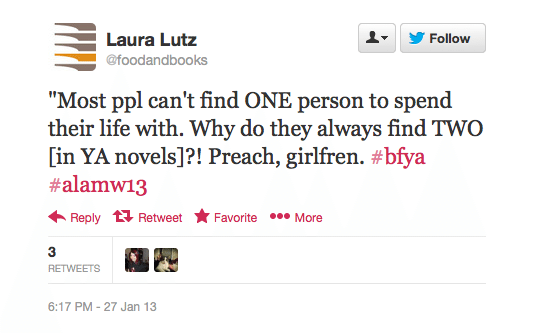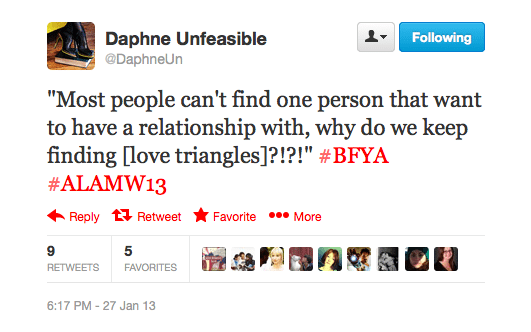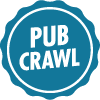In defense of love <del>triangles</del> interests
I've been thinking about love triangles ever since YALSA's BFYA Teen Feedback Session at ALA Midwinter. More specifically, ever since these two tweets, paraphrasing what one of the teens said during the panel, showed up in my feed:


Many tweets followed, all seeming to confirm that teens are love-triangled out. Now I'm not trying to discount the opinion stated in the above tweets. Nor am I questioning that readers are tired of love triangles. But I was rather perplexed by this idea that a character should have one main love interest and one only, because in my opinion (this post is going to be highly opinion-based, so take it with a grain of salt) it seems the opposite happens in real life. Not always, of course, but I think if you ask most people, they will say they flirted with/crushed on/dated one, two, a dozen, maybe more people before they found The One. So I started wondering what, exactly, might be rubbing readers the wrong way when it comes to love triangles? Is it any story in which the character has two potential partners? If so, why? Because it's not convincing? I'll admit it's difficult to write a solid, believable, and unpredictable love triangle, but they do exist. Cynthia Hand's UNEARTHLY series is a fabulous example of a triangle done right. (Again, my opinion.) But more than anything, I'm starting to wonder if it's a mislabeling of the term that's the issue for backlash. Lately, I've heard "love triangle" applied to almost any novel that has more than one potential love interest, and I think this is unfair. A triangle, at least by my personal definition, is one in which the main character is equally torn between two love interests. Both bring out different sides of the main character, and said character is deciding who they want to be, which in turn, often dictates who they choose as a partner. (Carrie Ryan wrote about this ages ago but it is still relevant and wonderfully stated.) Similarly, both love interests tend to be fighting for the main character's affection while he/she makes that final decision. So what are some of the books I feel have recently been labeled incorrectly? Let's take a look. (Be warned, very light spoilers exist in the following list.)
Through the Ever Night by Veronica Rossi, because a gal shows up mid-way through and tries to seduce Perry
Prodigy by Marie Lu, because Tess has started to develop feelings for Day which she makes known
Throne of Glass by Sarah J. Maas, because Celaena grows close to two different men while trying to win the title of King's Champion
Shades of Earth by Beth Revis, because a secondary character is crushing on Amy
Something Strange & Deadly by Susan Dennard, because Eleanor falls for Daniel while her mother tries to force her on a suitor
These stories have multiple possibilities—branches that would lead to very different outcomes—but no equally weighted "triangle." In my opinion they are "webs." Even still, I've heard the above described as love triangles by marketing departments and/or reviewers/bloggers. Is this doing the book a disservice? I don't know. I think so. Maybe. As the teen reactions at the BFYA panel show, a love triangle has become an undesirable trope recently, and so it seems that applying the term incorrectly could be dangerous. There's a bit of a negative connotation there, which could skew reader perspectives before they even pick up the book. (Not to mention how mislabeling things a "love triangle" dilutes the meaning of the term itself.) But negative connotations aside, I still love a well-done love triangle, and even more than triangles, I love complex "webs." I think they are the most natural sort of romantic tension, because they so wonderfully mirror life and human nature. People grow, hearts change, desires/dreams/expectations shift. Sometimes we are tempted. Sometimes we lust. Sometimes we are completely honest and true to one person, and other times we think we know who that one person is, only to meet someone else later who makes us question everything. The truth is that love is complicated, just as the original teen hinted at in the above tweet. Finding The One can require detours, wrong turns, mistakes, backtracking, and the navigating of a very, very complex web. Or, if you're lucky, the route could be a relatively well-marked, one way street. I love stories that effectively capture both. In the end, I guess I'm saying I support love triangles, lines, quadrilaterals, webs, you name it. I also support temptations and doubts and inner turmoil on the main character's end. So long as the romantic tension feels natural in the context of the story—honest and real to the character's emotional state and growth—I'm a fan. And this is the kicker, right? Because it's all subjective. How we identify romance and potential love interests will vary from reader to reader. (For more on reader perceptions, don't miss this fabulous post by Zoe Marriott about instalove.) But what about you? How do you feel about triangles and how do you go about defining them? What do you think about the "web" examples I listed above? I could discuss this stuff all day, so please leave me your thoughts in the comments!








